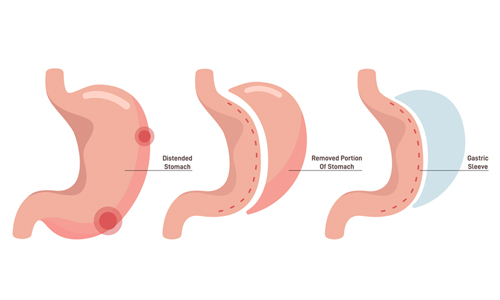How is gastric sleeve surgery performed?

How is gastric sleeve surgery performed?
Gastric Sleeve Surgery: A Detailed Guide and Everything You Need to Know
With the rising rates of obesity, there has been an increasing interest in bariatric surgery. Among these surgical methods, the most popular is gastric sleeve surgery (sleeve gastrectomy). Gastric sleeve surgery not only helps with weight loss but also plays a significant role in treating obesity-related diseases. In this article, we’ll delve into what gastric sleeve surgery is, how it is performed, and the post-operative process.
What is Gastric Sleeve Surgery?
Gastric sleeve surgery involves the surgical removal of approximately 75-80% of the stomach. As a result, the stomach takes on a narrow and long shape, resembling a banana or a sleeve. This reduces the stomach's capacity, allowing the patient to feel full after eating less food. Gastric sleeve surgery also reduces the production of ghrelin, a hormone involved in appetite control, helping patients feel less hungry.
How is Gastric Sleeve Surgery Performed?
-
Anesthesia and Preparation: The surgery is performed under general anesthesia. Before the procedure, the patient's medical history is reviewed, and necessary tests are conducted. The patient is informed about the dietary plan and the preparation process before surgery.
-
Laparoscopic Surgery: Gastric sleeve surgery is typically performed using laparoscopic techniques (minimally invasive surgery). In this method, 4-5 small incisions are made in the abdomen, and surgical instruments along with a camera are inserted. The surgeon performs the operation while viewing it on a screen.
-
Stomach Removal: During the surgery, a large portion of the stomach is removed. The remaining stomach is shaped like a narrow tube. This significantly limits food intake and provides a quick feeling of fullness.
-
Stitching and Leak Test: After the sleeve is created, special tests are performed to check for any leaks at the surgical site. These tests help prevent post-operative complications.

Advantages of Gastric Sleeve Surgery
- Weight Loss: Gastric sleeve surgery results in significant weight loss. Within the first year, patients can lose 60-70% of their excess weight.
- Hormonal Control: Reduced ghrelin levels make it easier to control appetite.
- Treatment of Metabolic Diseases: Conditions like type 2 diabetes and hypertension show significant improvement.
Post-Surgery Process
After gastric sleeve surgery, the dietary pattern undergoes a major transformation. The diet begins with liquid foods, progresses to purees and soft foods, and returns to normal eating after 4-6 weeks. Patients must adopt healthy eating habits by consuming small portions slowly. Additionally, vitamin and mineral supplements become important after surgery.
Risks of Gastric Sleeve Surgery
Like any surgical procedure, gastric sleeve surgery carries some risks. These include infection, bleeding, leakage at the staple line, and nutritional deficiencies. However, these risks can be minimized with an experienced surgeon and thorough post-operative care.
Who is Eligible for Gastric Sleeve Surgery?
Typically, candidates for gastric sleeve surgery are those with a body mass index (BMI) of 40 or above, or those with a BMI over 35 who have obesity-related health issues. Additionally, candidates should have previously struggled to lose weight through diet, exercise, and medication.
Contact Form
Do you know?
As EmseClinic, we provide free preliminary examination service to our patients. To benefit from our service, all you have to do is leave us a form and our customer representative will contact you as soon as possible and answer your questions.